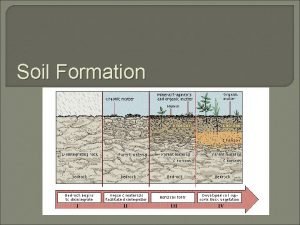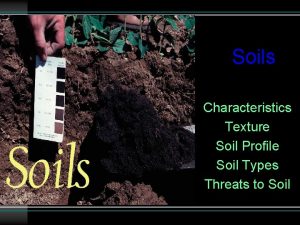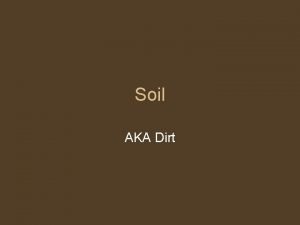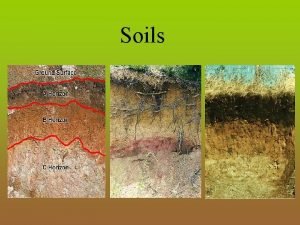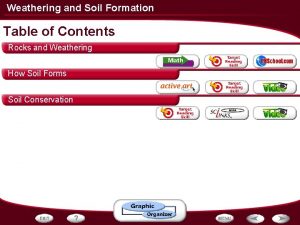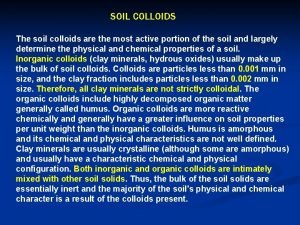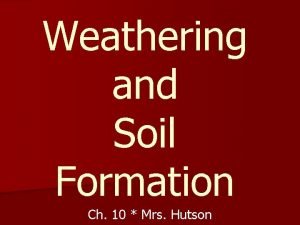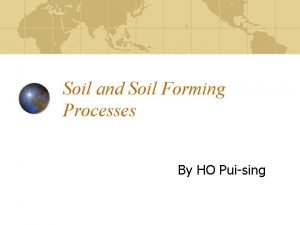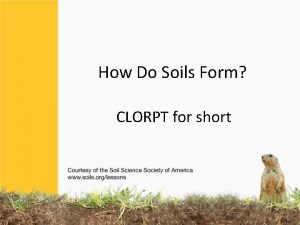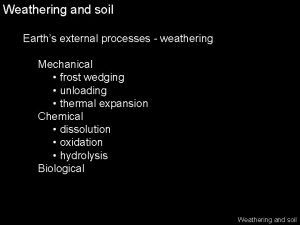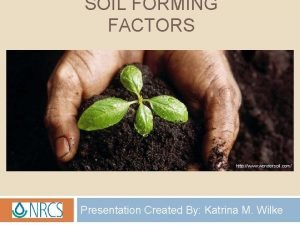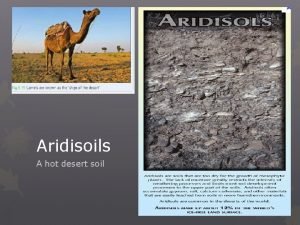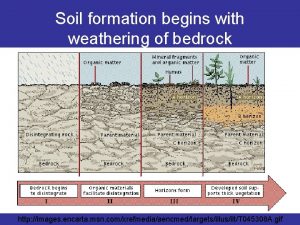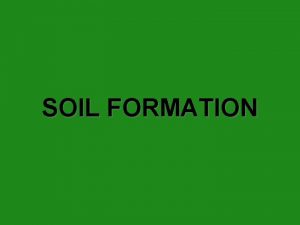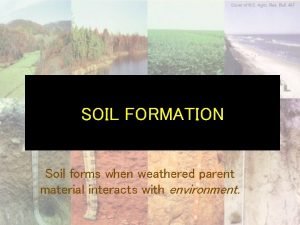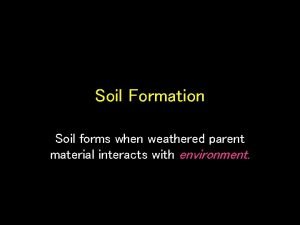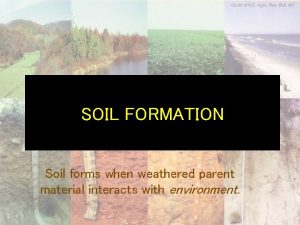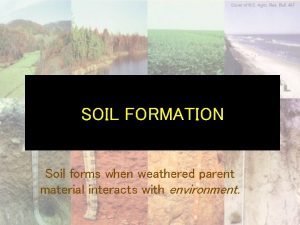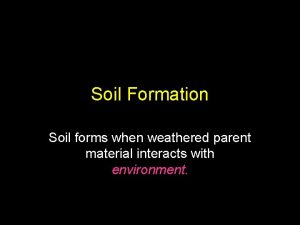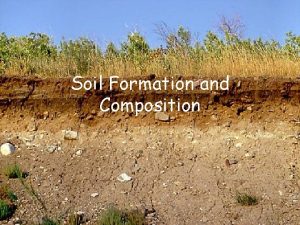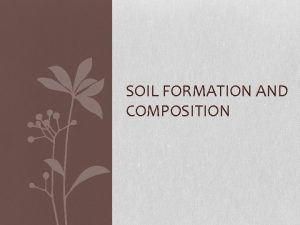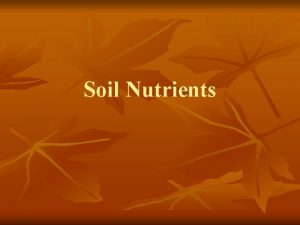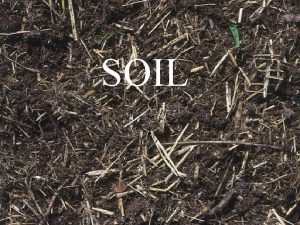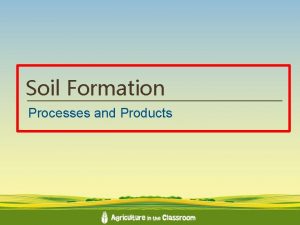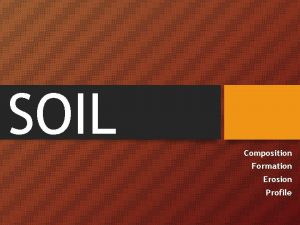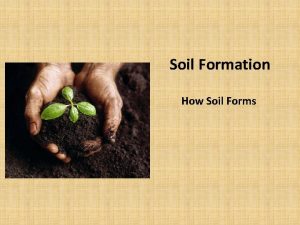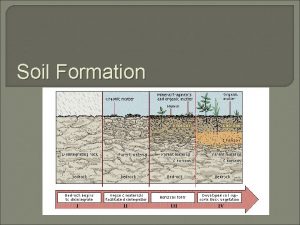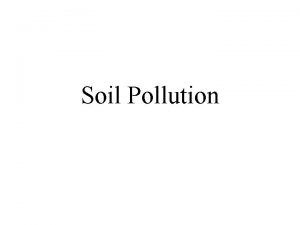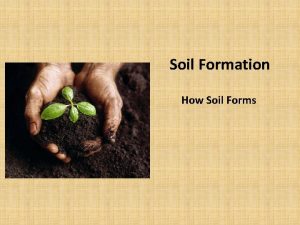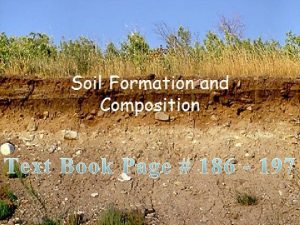Soil Formation of soil from the parent material


















































- Slides: 50

Soil • Formation of soil from the parent material (bedrock): mechanical weathering of rocks by temperature changes, wind, moving water, glaciers and chemical weathering activities. • Under ideal climatic conditions, soft parent material may develop into 1 cm of soil within 15 years.

OMG !!!! “Not in My Backyard!!”

Soil or Land Pollution • Land pollution is the degradation of the Earth's land surface through misuse of the soil by poor agricultural practices, mineral exploitation, industrial waste dumping, and indiscriminate disposal of urban wastes. • Land pollution is the degradation of earth's land surfaces often caused by human activities and its misuse. Haphazard disposal of urban and industrial wastes, exploitation of minerals, and improper use of soil by inadequate agricultural practices are a few of the contributing factors. • 15% of the total land area in the World is degraded to various degrees. About 55 % of this area has been degraded by water erosion, 28% by wind erosion and 12% by chemical factors such as water logging etc. • The main causes of land degrading are overgrazing and deforestation

Major types of soil Pollutants • Heavy Metals: Heavy metals accumulate in the top few inches of soil, where they can leach into feed portion which is taken up by the animals and other higher order degree receives even higher concentration. Important organs of human body kidneys, liver and nervous system are affected. • Dioxins: Dioxins are the bi-products released with the production of pesticides and other industrial processes. They are released in the air and get settled in the soil. Contamination of these lead to nerve and liver damage. • Pesticides, fertilizers and other agricultural Products: All these promote the development of cancer or impair the normal functioning of the endocrine system. Many fertilizers contain toxic levels of heavy metals.

• Lead: Small amount of lead occur naturally in the soil and also it enters from the deposits left by automobile exhaust when leaded gasoline is used. The main source of lead is the lead battery manufacturing plants or brass foundries. Lead if ingested with food or water causes severe damage to the nervous system, reproductive and urinary system. • Cadmium: Cadmium is used in metallurgical and electronic industries and is one of the most frequently registered metallic pollutants. It is released from metallurgical industries or by the application of Phosphorus fertilizers in agriculture. • Detergents and petroleum products may also contribute to its circulation as an environmental pollutant. Long term exposure to cadmium may lead to renal dysfunction and obstructive long disease.

Other Sources of Land Pollution • • • Industrial Waste Urban Waste Radioactive Pollutants Agricultural Practices Chemical and Metallic Pollutants Biological Agents (bacteria, viruses, fungi, other microorganisms and their associated toxins)


Natural Causes: Earthquakes, landslides, hurricanes and floods. Man Made Causes: • Industrial Waste: It contains different types of toxic , flamable and non biodegradable substances that may persist in the soil for a long time and destroy the composition of the soil. • Urbanisation: Large areas of forest and agricultural land are utilized for residential, commercial and industrial purposes. It is associated with industrialization, construction of dams , houses and factories etc leaves the land in the adjacent areas unfit for agriculture. • Mining: Mining activities cause contamination of ground water and surface water by discharging th toxic mining products into the environment.

• Agricultural Waste: Biodegradable wastes such as straw, dry twigs, leaves, seeds, grasses increase the fertility while the excessive use of fertilizers and pesticides degrades the soil quality. • Domestic Waste and Garbage: Domestic wastes such as kitchen and food wastes, paper, cloth and non biodegradable such as glass, plastic materials, metal cans. Improper disposal of hazardous domestic wastes such as batteries , paints , medicines, glass bulbs, spray cans etc contribute greatly to soil pollution. • Radioactive Wastes: Nuclear power plants, nuclear testing and explosions add variable amount of radioactive materials to the soil.

OTHER CAUSES OF SOIL DEGRADATION • Soil erosion/degradation is the loss of top soil erodes fertility of soil & reduces its water-holding capacity. • : Excessive farming, construction, overgrazing, burning of grass cover and deforestation • Excess salts and water (Salinization) • Solid waste

Most Affected Persons In general, residents in low income, minority neighborhoods are more likely to live near: chemical waste dumping sites; electric power plants; municipal incinerators; solid waste landfills; industrial plants; and heavily traveled roadways.

Effects of Soil Pollution • Disposal of industrial wastes leads to degrading of the soil • Urban wastes consists of non-biodegradable substances that are retained in the soil for a long time and slowly poison the soil damaging its fertility. • Soil pollution causes fertile lands to become barren • Radioactive elements that are present in the polluted soil enter the food chain through plants. This cause the adverse health effects such as cancer, deformities in bones etc.

Hazards from Waste • Municipal solid waste includes residential and industrial waste. Solid waste is usually disposed of in landfills or recycled • Hazardous waste, defined as that which is toxic, corrosive, flammable, or ignitable needs to be disposed of properly. • Nuclear waste raise concerns about potential radiation exposure. • Sources are commercial power plants, hospitals, and nonmilitary sources nuclear power plants

Control of soil pollution • Industrial wastes and effluents must be treated before the being disposed. It will reduce the toxicity and harmful elements present in them thus reducing the soil pollution. • Garbage from urban areas should be segregated into biodegradable and non biodegradable waste products. Biodegradable wastes such as glass, metals and plastics may be recycled and reused. • Planting of trees must be encouraged. Trees and plants utilize many of the pollutants during the process of photosynthesis and hence reduce the severity of soil pollution, they also bind the soil together and prevent the loss of fertile topsoil during heavy rains and floods. • The disposal of hazardous radioactive wastes into the soil should be prohibited as it is almost impossible to completely clans the soil of radioactive elements. • Solid waste can also be used for electricity generation by using garbage 14

• The usage of chemical fertilizers and pesticides should be minimized as far as possible. • Use of pesticides and fertilizers should be minimized. • Cropping techniques should be improved to prevent growth of weeds. • Special pits should be selected for dumping wastes. • Controlled grazing and forest management. • Wind breaks and wind shield in areas exposed to wind erosion • Afforestation and reforestation. 15

Bioremediation • The use of naturally occurring microorganisms such as bacteria, fungi & plants to break down or degrade toxic chemical compounds that have accumulated in the environment • It is a method that treats the soils and renders them non-hazardous, thus eliminating any future liability that may result from landfill problems or violations.

Two Types • In situ Bioremediation : The treatment in place without excavation of contaminated soils or sediments. • Ex situ bioremediation: requires pumping of the groundwater or excavation of contaminated soil prior to remediation treatments.

In-situ-Bioremediation • Good for large volumes Slower • Doesn’t work well in clays or highly layered subsurface • Less expensive • Creates less dust • Less possibility of contaminant release into environment

Ex-situ -Bioremediation • Slurry-phase-Soil combined with water/additives in tank, microorganisms, nutrients, oxygen added • Solid-phase – Land-farming: soil put on pad, leachate collected – Soil biopiles: soil heaped, air added – Composting: biodegradable waste mixed with bulking agent – Land Applied –waste added directly to soil which is later planted to a crop. • Easier to control • Used to treat wider range of contaminants and soil types • Costly • Faster

Slurry, Solid Phase, & Land Applied

Advantages of Using Bioremediation Processes Compared With Other Remediation Technologies (1) Biologically-based remediation detoxifies hazardous substances instead of merely transferring contaminants from on environmental medium to another; (2) Bioremediation is generally less disruptive to the environment than excavation-based processes; and (3) bioremediation technologies can be considerably lower than that for conventional treatment methods: vacuuming, absorbing, burning, dispersing, or moving the material.

1. People should not cut trees for making furniture. 2. People should not throw garbage on land. 3. Plastic bags should be avoided for prevention of land pollution. 4. Industries should not throw there waste on land.

Controlling Land Pollution • How can you eliminate or reduce waste? – Recycle- use materials that can be recycled and reprocessed into other items (recycle paper, bottles, cans, glass) – Reuse- use materials that can be reused again and again (Regular plates & cups instead of paper or plastic, reusable water bottles) – Reduce- use less paper, use pencil that are refillable

Reducing Volume • Disposable items = ¼ of landfill waste – Cloth napkins instead of paper – Clothe dishtowels instead of paper • Repair broken items – TVs, dishwashers, fridges, furniture • Utilize recycling programs – Paper, metal, cardboard, plastic, gas, cooking oil, vehicle oil

• Biodegradable wastes- yard clippings, leaves, branches – Use to make humus or mulch for your house – Most cities- pick up & mulch for you: Dispose of separately & not in regular garbage

Using Plants for pollution cleanup • Scientists are studying how plants can be used to bind up soil pollution found at national nuclear laboratories and nuclear power plants, where radioactive and other toxic wastes may reach groundwater. • Plants, soil, and microbes in the soil work together to determine which metals and nutrients plants take up from the soil. • Some plants excrete a variety of different chemicals into the soil, some of which act as signals to soil organisms. • The challenge is to find out how plants release these chemicals and how these chemicals interact with microbes and soil. • Eventually scientists may be able • to induce plants to release the chemicals that immobilize wastes in the soil. Teresa Fan at UC Davis is studying how plants can be used to remove toxic wastes from soil.

Land pollution management • • • Integrated Solid Waste Management Good agricultural practices Remediation of polluted soils Prevention of erosion and silting Containment of hazardous waste and waste water treatment using land treatment techniques.

Solid Waste Management

• The combination of industrialisation and the rapid increase in population and urbanisation has greatly increased the generation of solid wastes. • Owing to these facts, earth is rapidly being converted into a dumping ground of non biodegradable solid wastes. • Solid wastes are responsible for land pollution in urban and industrial areas.

Classification of Solid Wastes and their Sources • Solid waste- vegetable waste, kitchen waste, household waste etc. • E-waste- discarded electronic devices like computer, TV, music systems etc. • Liquid waste- water used for different industries eg tanneries, distillaries, thermal power plants • Plastic waste- plastic bags, bottles, buckets etc. • Metal waste- unused metal sheet, metal scraps etc. • Nuclear waste- unused materials from nuclear power plants, nuclear explosions. • These wastes need special consideration before they are disposed into the biosphere.

• Agriculture waste - These wastes results from farms, feedlots and livestock yards and may include paddy husk, bagasse from sugarcane, tobacco and corn residues. • Hospital Wastes: It includes disposable needles, syringes, blades, blood-soaked bandages, human flesh, issues and more such items that may cause contagious diseases. Hospitals waste may deal to highly infectious diseases in those people coming in direct contact. So this waste require management. • Mining Wastes: Mining activities result in the generation of a lot of waste material such as substances that are removed to get to the useful minerals e. g topsoil, rocks

Waste- Definition & Classification Any material which is not needed by the owner, producer or processor. Classification • • • Domestic waste Factory waste Waste from oil factory E-waste Construction waste Agricultural waste Food processing waste Bio-medical waste Nuclear waste

Solid Waste


Effects of Solid Wastes • Urban and Industrial wastes have observed to have the following adverse effects. • Accumulation of solid wastes leads to increase in the population of disease-causing organisms such as mosquitoes flies etc. • The solid waste run off with the rainwater and mixes with the nearby water bodies causing water pollution. • Burning of solid waste leads to air pollution. • Radioactive soild waste cause a no. of problems • Presence of large dumps of solid wastes reduces aesthetic value of the land

Growth of Solid Waste In India • Waste is growing by leaps & bounds • In 1981 -91, population of Mumbai increased from 8. 2 million to 12. 3 million • During the same period, municipal solid waste has grown from 3200 tonnes to 5355 tonne, an increase of 67% • Waste collection is very low for all Indian cities • City like Bangalore produces 2000 tonnes of waste per annum, the ever increasing waste has put pressure on hygienic condition of the city Source: The Energy & Resources Institute, New Delhi

Solid Waste in India • 7. 2 million tonnes of hazardous waste • One Sq km of additional landfill area every-year • Rs 1600 crore for treatment & disposal of these wastes • In addition to this industries discharge about 150 million tonnes of high volume low hazard waste every year, which is mostly dumped on open low lying land areas. Source: Estimate of Ministry of Environment & Forest

Control Measures of Urban and Industrial Wastes A large no. of NGOs are working in the field of solid waste management such as ‘Clean Ahmadabad Abhiyan’ in Ahmadabad, ‘Waste-Wise’ in Banglore and ‘Vatavaran’ and ‘Srishti’ in Delhi. Solid waste management is a three step process. 1. Collection of Solid Waste: • Primarily by the city municipality -No gradation of waste product eg bio-degradable, glasses, polybags, paper shreds etc -Dumps these wastes to the city outskirts • Local raddiwala / kabadiwala (Rag pickers) -Collecting small iron pieces by magnets -Collecting glass bottles -Collecting paper for recycling • MCD- Sophisticated DWM (Delhi Waste Management) vehicle

2. Transportation of Solid Waste: The next step in the solid waste management is the transportation of solid waste from urban areas to the dumping grounds. The means of transport used are tractors, trucks etc. Overloading of these should be avoided to prevent spilling of garbage along the way. 3. Disposal of Solid Waste: It is estimated that if suitable methods were not adopted for the solid waste management then by 2047 then more than 1400 square km of land (equivalent to size of Delhi) would be converted to dumping grounds. At present the following methods are adopted for the disposal of solid waste.

• Open Dumping: It is a common method of waste disposal where the waste is dumped in open without being covered or protected. This leads to the growth of flies and mosquitoes and also cause soil and land pollution. • Landfills: It is a another common method of waste disposal. In this the waste is covered by a thick layer of soil. It reduces the risk of diseases in human beings, however it contaminates the ground water and make land unfit for agriculture. • Ocean Dumping: Many of the industrial effluents containing poisonous chemicals are dumped into the oceans . Every year app. 38 million tons of waste is dumped in coastal and estuaries areas. It affects the marine ecosystem

Open dumping Land fills Ocean dumping

• Incineration: In this method the combustible waste is burnt at a high temperature such that combustible substances are reduced to ash and other non combustible materials. By this method waste is reduced from 75% to 95%. But this leads to air pollution. • Composting: Compost is organic matter that has been decomposed and recycled as a fertilizer and soil amendment. Compost is a key ingredient in organic farming • Reduction at Source: The best possible technique for the solid waste management would be reduction at source. It can be don by using 5 R’s Principles.

• Refuse: It is important to refuse unnecessary good and services. For example plastic bags are extensively used in packing and carrying the materials so it is necessary to minimise their use and people should use Cloth bags. • Reduce: It is essential to reduce the consumption of good and services as much as possible. For example use of electricity in homes and industries. By saving electricity it would be possible to save precious coal resources used for generating electricity in thermal plants. Production of Hydroelectricity should be promoted. • Reuse: The next crucial step to minimise wastage is to reuse goods. This will reduce the demand for goods. This would reduce the exploitation of natural resources. e. g By reusing bottles and cans, you can save money and contribute to a better environment. For example, some jams are sold in reusable drinking glasses. You can even bottle your own jams or preserved fruits in reusable jars.

• Repair: It is advisable to repair broken goods and try to use them for a longer time and then discarding them. It will reduce the need for new goods and saves the natural resources used in their production. e. g. Repairing old furniture and putting it to use is cost effective and eco friendly option compared to buying new furniture. • Recycle: The most popular method of preventing wastage is to recycle goods. e. g paper can be recycled and converted to variu usable forms. This will reduce the demand of wood pulp and save trees.

Collection & Recycling of Waste Materials

Pollution Prevention Act • 1990 - Focused on reducing generation of pollutants at point of origin; rather than reduction of pollutants after or repair of damage they cause – Requires manufacturing companies to report reduction & recycling activities to EPA yearly

Problems with Plastics • Less than 20% of plastics are recycled – Expense of making new vs. recycling old – Driven by economics – Some local govts support or require recycling • So many different kinds of plastic creates challenge for recycling – Sort & separating

Recycled Tyre Products • Few products made from old tyres – Retreads, playground eq, garden hoses • Habitat reconstruction – Reef building (Georgia Coastal Resources • Roads-rubberized asphalt • EPA- 9% of tyres recycled – Most states have recycling programs for tyres

Managing Waste Recycling: Processing of a waste item into usable forms. Benefits of recycling: -Reduce environmental degradation -Making money out of waste -Save energy that would have gone into waste handling & product manufacture Saving through recycling: -Making paper from waste saves 50% energy -Every tonne of recycled glass saves energy equivalent to 100 litres of oil

 Soil profile
Soil profile C horizon characteristics
C horizon characteristics Soil located above its parent material
Soil located above its parent material Soil horizon parent material
Soil horizon parent material Formation initiale vs formation continue
Formation initiale vs formation continue White mangrove
White mangrove Weathering types
Weathering types 5 factors of soil formation
5 factors of soil formation What is soil colloids
What is soil colloids Venn diagram of chemical and mechanical weathering
Venn diagram of chemical and mechanical weathering Plastic limit
Plastic limit What is soil formation
What is soil formation Eluviation and illuviation
Eluviation and illuviation Clorpt
Clorpt Venn diagram of mechanical and chemical weathering
Venn diagram of mechanical and chemical weathering Factors of soil formation
Factors of soil formation Soil temperature ppt
Soil temperature ppt Desert soil composition
Desert soil composition Soil formation begins with the weathering of
Soil formation begins with the weathering of Soil textural triangle practice exercises
Soil textural triangle practice exercises Living soil vs dead soil
Living soil vs dead soil Convergent plate boundaries
Convergent plate boundaries Geometric symbol
Geometric symbol Non material culture examples
Non material culture examples Standard costing and variance analysis formulas
Standard costing and variance analysis formulas Useful materials examples
Useful materials examples Material culture example
Material culture example Refers to the knowledge language values customs
Refers to the knowledge language values customs Nguyên nhân của sự mỏi cơ sinh 8
Nguyên nhân của sự mỏi cơ sinh 8 Trời xanh đây là của chúng ta thể thơ
Trời xanh đây là của chúng ta thể thơ Voi kéo gỗ như thế nào
Voi kéo gỗ như thế nào Thiếu nhi thế giới liên hoan
Thiếu nhi thế giới liên hoan Tia chieu sa te
Tia chieu sa te Các châu lục và đại dương trên thế giới
Các châu lục và đại dương trên thế giới Một số thể thơ truyền thống
Một số thể thơ truyền thống Thế nào là hệ số cao nhất
Thế nào là hệ số cao nhất Sơ đồ cơ thể người
Sơ đồ cơ thể người Tư thế ngồi viết
Tư thế ngồi viết Bảng số nguyên tố
Bảng số nguyên tố đặc điểm cơ thể của người tối cổ
đặc điểm cơ thể của người tối cổ Mật thư anh em như thể tay chân
Mật thư anh em như thể tay chân Tư thế worm breton
Tư thế worm breton ưu thế lai là gì
ưu thế lai là gì Thẻ vin
Thẻ vin Thể thơ truyền thống
Thể thơ truyền thống Cái miệng xinh xinh thế chỉ nói điều hay thôi
Cái miệng xinh xinh thế chỉ nói điều hay thôi Các châu lục và đại dương trên thế giới
Các châu lục và đại dương trên thế giới Bổ thể
Bổ thể Từ ngữ thể hiện lòng nhân hậu
Từ ngữ thể hiện lòng nhân hậu Diễn thế sinh thái là
Diễn thế sinh thái là
